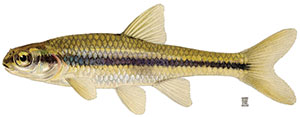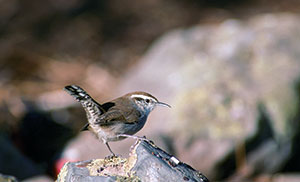Introduction

Ellen Edmonson and Hugh Chrisp, 1927–1940 N.Y. Biological Survey
The NPS Inventory And Monitoring Program (I&M) was established in 1992 to develop a scientific understanding of the physical, chemical, and biological elements and processes of park ecosystems that shape the overall “health” or condition of park resources occurring in more than 270 national parks. The primary purpose of the program is to deliver to parks the science needed to manage their natural resources, beginning with 12 basic inventories:
- Natural resource bibliography (IRMA Data Store)
- Base cartography
- Air quality
- Air quality–related values
- Climate
- Geologic resources
- Soil resources
- Water body location and classification (including wells)
- Baseline water quality
- Vegetation (vascular plants)
- Species lists (NPSpecies)
- Species occurrence and distribution of vascular plants, birds, mammals, fish, amphibians, and reptiles

USFWS/Dave Menke; NCTC Image Library
While certain inventories such as base line water quality (benthic macroinver tebrates), vegetation, and species lists directly inform our understanding of bio diversity in parks, others, such as climate, geology, and soils, are central to understanding the environments and processes that have led to diversification. Thus, both the biotic and abiotic components of the 12 natural resource inventories contribute to our growing body of knowledge of park biodiversity.
The inventories have shaped our understanding of biodiversity and facilitated its discovery in parks across the country. The Kahuku plant inventory at Hawaii Volcanoes National Park discovered a total of 455 vascular plant species, including 5 endangered species and 26 locally rare, native species. During vegetation mapping at the Blue Ridge Parkway (North Carolina and Virginia), 75 distinct plant communities were documented within the park, of which 24 are considered globally rare and 7 are considered globally imperiled. Herpetological surveys at Sleeping Bear Dunes National Lakeshore (Michigan) revealed 4 new species of reptiles and amphibians. At Delaware Water Gap National Recreation Area (Pennsylvania and New Jersey) and Upper Delaware Scenic and Recreational River (Pennsylvania and New York), several species of fishes that were previously considered to be rare or uncertain are now known to be relatively widespread in the two parks, and another very rare species (the bridle shiner, Notropis bifrenatus; see photo, above) was discovered at several new sites. A bird species thought to be extirpated from Chickamauga and Chattanooga National Military Park in Georgia and Tennessee (Bewick’s wren, Thryomanes bewickii, below) was (re)discovered breeding, providing the first such evidence in the re gion since the early 1980s. At Craters of the Moon National Monument and Preserve (Idaho), pika (Ochotona princeps) were detected at several historical (recolonized) and many new locations.
Monitoring and biodiversity
Our knowledge and understanding of park biodiversity continue to grow beyond the inventories through long-term monitoring that tracks the health of park resources. More than 30 major categories of natural resources and indicators are monitored nationally by the I&M Program. Monitoring results routinely include the documentation of new species and, in some cases, rediscovery of species we thought were lost. For example, bird monitoring in the Southwest adds, on average, five new species of birds to park species lists each year. Two species of bats and a lady-slipper orchid, all listed as critically imperiled by NatureServe, were documented in Big South Fork National River and Recreation Area (Tennessee and Kentucky). Two species not seen in parks in more than 30 years have been documented through monitoring: spadefoot toad in Yellowstone National Park (Wyoming, Montana, and Idaho) and a freshwater sponge in Rock Creek Park (Washington, D.C.). Species identification for the sponge is pending.
Monitoring has helped document changes in biodiversity and why the changes have occurred. For example, stream monitoring conducted by the Rocky Mountain I&M Network and other collaborative stream sampling efforts in and around Glacier National Park (Montana) have resulted in the discovery of 26 new-to-science species of diatoms from Waterton-Glacier International Peace Park. Diatoms are important bioindicators that reflect water quality conditions. The Great Lakes I&M Network sampled about 60 sites across network parks. Results show that many of the lakes, especially those that are shallow, are experiencing rapid changes in diatom species composition. Sediment cores collected from at least one lake in most of this network’s parks reflect water quality conditions for the past 150–200 years. Biological changes from the 1970s to 1980s, as reflected by diatom composition, are best explained by changes in climate rather than land use. Water temperature monitoring will help determine the extent to which climate change is driving changes in diatoms and water quality.
By focusing on the highest-priority measurements of park resource condition, I&M results and findings provide early warning of situations that require management intervention. This contribution to management is attainable without a fully comprehensive understanding of park biodiversity because species have interactions and dependencies both within and among park ecosystems. National Park Service and National Geographic Society BioBlitzes thus complement the Inventory and Monitoring Program by expanding our knowledge of the biological resources in parks. For example, nonvascular plants and invertebrates are two groups of taxa considered by bioblitzes that have not been systematically inventoried. Bioblitzes can help parks understand the diversity, distribution, and abundance of these taxa, along with others such as fungi and microbes. Knowledge gained through park bioblitzes adds to our inventories and, as with all science, bioblitzes help identify and highlight questions for future study. NPSpecies is the centralized NPS resource for archiving and curating these observations in support of future science.
About the authors
William Monahan is an ecologist with the NPS Inventory and Monitoring Division in Fort Collins, Colorado. Kirsten Gallo is chief of the NPS Inventory and Monitoring Division in Fort Collins, Colorado.
More information
Online: 14 August 2018; in print: 25 November 2014
URL
https://www.nps.gov/articles/imparkbiodiversity.htm
Suggested citation
Monahan, W. and K. Gallo. 2014. Inventory and monintoring of park biodiversity. Park Science 31(1):18–19.
This page updated
28 August 2018
Site navigation
Volume 31, Number 1
Park Science homepage
Part of a series of articles titled Park Science 31(1)—Special Issue 2014.
Previous: Ben Clark, Biodiversity Youth Ambasador
Last updated: August 28, 2018
